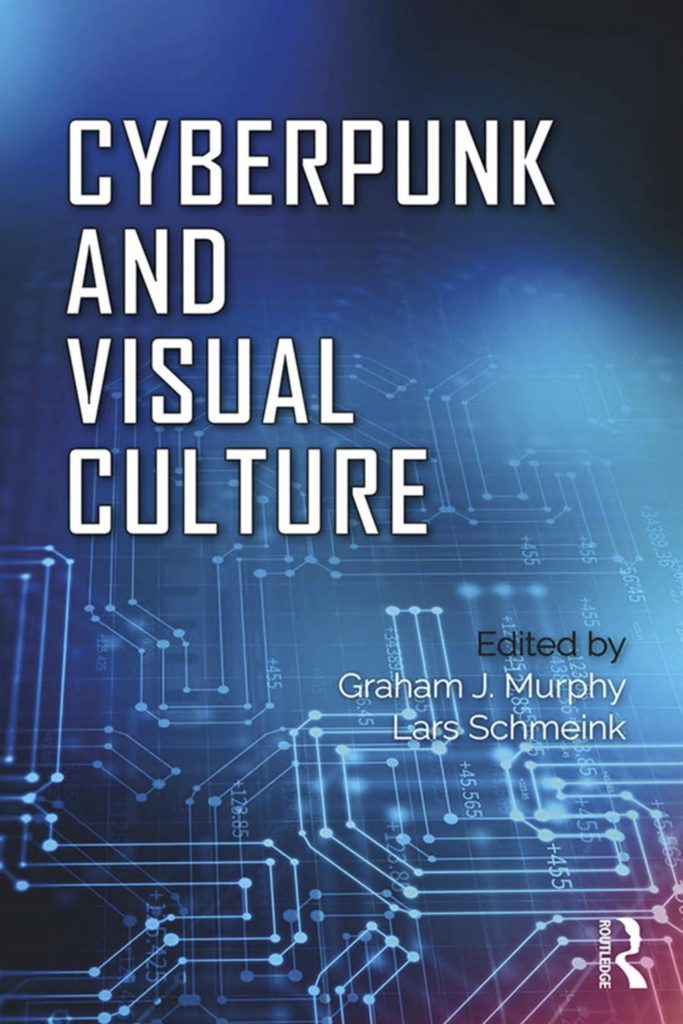The 15 essays gathered into Cyberpunk and Visual Culture engage the social and cultural changes that define our cyberpunk moment(s) and address the visual language and aesthetic repertoire of cyberpunk – from cybernetic organisms to light, energy, and data flows, from video screens to cityscapes, from the vibrant energy of today’s video games to the visual hues of comic book panels, and more. Unlike other anthologies that limit their analytical apparatus to literary cyberpunk, the essays of Cyberpunk and Visual Culture provide critical analysis, close readings, and aesthetic interpretations of exactly those visual elements that define cyberpunk today, moving beyond the limitations of merely printed text to also focus on the meaningfulness of images, forms, and compositions that are the heart and lifeblood of cyberpunk graphic novels, films, television shows, and video games.

The report of cyberpunk’s death was an exaggeration, clearly, as the essays in this vibrant collection demonstrate. The ambiguities, complexities and excitements of this intermedial genre are explored here in riveting detail: the legacy of Gibson’s ‘lines of light’ are demonstrated to be, indeed, unthinkably complex.
Stacy Gillis, Newcastle University
Table of Contents
Introductory Material
- Scott Bukatman – Foreword: Cyberpunk and its Visual Vicissitudes
- Graham J. Murphy and Lars Schmeink – Introduction: The Visuality and Virtuality of Cyberpunk
I: „Image/Text Concatenations“; or, From Literary to Visual Cyberpunk (and back again)
- Christian Hviid Mortensen – Beyond the Heroics of Gonzo-Journalism in Transmetropolitan
- Timothy Wilcox – Embodying Failures of the Imagination: Defending the Posthuman in The Surrogates
- Graham J. Murphy – Cyberpunk Urbanism and Subnatural Bugs in BOOM! Studios’ Do Androids Dream of Electric Sheep?
- Stina Attebery and Josh Pearson – „Today’s Cyborg is Stylish“: The Humanity Cost of Posthuman Fashion in Cyberpunk 2020
- Pawel Frelik – „Silhouettes of Strange Illuminated Mannequins“: Cyberpunk’s Incarnations of Light
II: „Tactics of Visualization“; or, From Visual to Virtual Cyberpunk (and back again)
- Christopher McGunnigle – „My Targeting System is a Little Messed Up“: The Cyborg Gaze in the RoboCop Media Franchise
- Ryan J. Cox – Kusanagi’s Body: Dualism and the Performance of Identity in Ghost in the Shell and Stand Alone Complex
- Mark R. Johnson – The History of Cyberspace Aesthetics in Video Games
- Stephen Joyce – Playing for Virtually Real: Cyberpunk Aesthetics and Ethics in Deus Ex: Human Revolution
- Jenna Ng and Jamie Macdonald – „We Are Data“: The Cyberpunk Imaginary of Data Worlds in Watch Dogs
III: „Emerging World Orders“; or, Cyberpunk as Science Fiction Realism
- Evan Torner – 1980s German Cyberpunk Cinema: Kamikaze 1989 and Nuclearvision
- Mark Bould – Afrocyberpunk Cinema: The Postcolony Finds its own Use for Things
- Anna McFarlane – Cyberpunk and „Science Fiction Realism“ in Kathryn Bigelow’s Strange Days and Zero Dark Thirty
- Sherryl Vint – Cyberwar: The Convergence of Virtual and Material Battlefields in Cyberpunk Cinema
- Lars Schmeink – Afterthoughts: Cyberpunk Engagements with Countervisuality